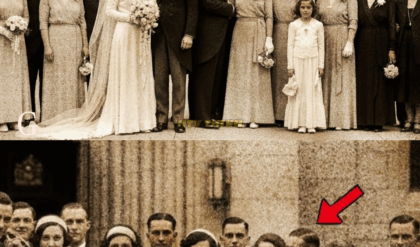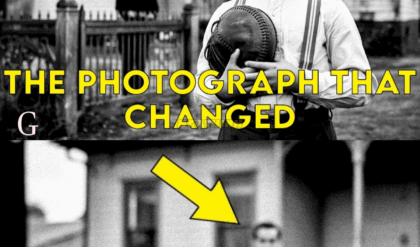A Boy Poses with His Ball in 1910: The Mystery That Shocked the City 🎾
It was the year 1910, and the streets of a small city in the United States were alive with the buzz of change. The world was on the cusp of the modern era—cars were becoming more common, and the echoes of the industrial revolution still reverberated in every corner of society. But on a bright, unassuming afternoon in the heart of the city, a photograph was taken that would forever remain a haunting enigma, one that would shake the very foundation of the community for generations to come.

A young boy, no older than 10, stood in front of a modest home on a quiet street. He smiled slightly as he held a ball in his hands. The photograph, taken by a local photographer who had gained a bit of fame for his candid snapshots, seemed like any other. The boy’s clothes were typical for the time—simple, a bit worn, but tidy. His face, though, seemed to carry a look of sadness beneath the smile. It was a look that would go unnoticed by most, but to those who would later analyze the picture, it would prove to be an unsettling clue.
The mystery began only days after the photograph was developed.
The Disappearance of the Boy 🕵️♂️
Just a week after the photo was taken, the boy, known only as William Albright, vanished without a trace. His parents, who lived in the small, tight-knit neighborhood, were frantic. William had been the picture of innocence, an ordinary boy with no apparent enemies, no reason to disappear. His family searched high and low, but it was as if he had vanished into thin air.
The photograph, innocuous at first, quickly became a symbol of a mystery that no one could solve. The boy in the picture, with his ball and his mysterious smile, was now the focus of every investigation. Had he run away? Had he been kidnapped? Or was there something more sinister at play?
The Cryptic Clue in the Photograph 📸
As investigators began to dig deeper into William’s disappearance, a peculiar discovery was made. The ball he was holding in the photo was not a typical one—it was a rare, handcrafted artifact that had only been sold in a single store in the entire city. This led many to believe that the boy’s disappearance was linked to someone with knowledge of rare items, possibly a collector, or worse, someone involved in shady dealings. But the most chilling detail came not from the ball, but from the boy’s eyes. His expression in the photograph was something that no one could ignore—a look of knowing, a deep, unsettling gaze that seemed to pierce through the camera lens.
Some of the locals began to whisper. Had the boy known something about his fate before it even happened? Was he, in some way, connected to the dark undercurrents that ran beneath the city’s peaceful facade?
The Investigation Takes a Dark Turn 🔎
As the investigation deepened, rumors swirled, each more bizarre than the last. The police were stumped. There were no signs of a struggle, no ransom notes, and no witnesses to the boy’s disappearance. But then, just when the case seemed to be slipping into obscurity, an anonymous letter arrived at the police station. The letter was typed on a machine and had no return address. It simply read:
“The boy knew too much. He was going to tell the world about the deal. The ball was the only thing left to remind him of the consequences.”
This cryptic message sent the investigation into a frenzy. What deal? What had the boy known? Some believed that it hinted at a secret network operating under the city, possibly tied to the city’s underground criminal dealings, while others thought it was the ramblings of a lunatic.
The Truth, But Not the Whole Truth 👀
As the years passed, the case of William Albright’s disappearance slowly became one of the city’s greatest unsolved mysteries. While many speculated about the boy’s fate, no one could ever explain the photograph, nor the strange expression that had haunted the investigators. In 1923, a breakthrough came. A group of amateur historians discovered an old newspaper clipping from 1910, just days before William’s disappearance. The article was about a large business deal between several prominent figures in the city, and it mentioned a “boy who would be an obstacle.” Was this the same boy?
However, the truth about William’s disappearance was never fully revealed, and the story became one of those that city residents would tell their children—a haunting reminder of how something as simple as a photograph could contain secrets so deep that they could never be fully understood.
Was it just a coincidence? Or was there a dark side to the city that no one ever spoke about? The boy’s photograph, captured so innocently, remained a chilling reminder of the mystery that had shocked the city in 1910—a mystery that, to this day, still lingers in the shadows of the city’s past.





